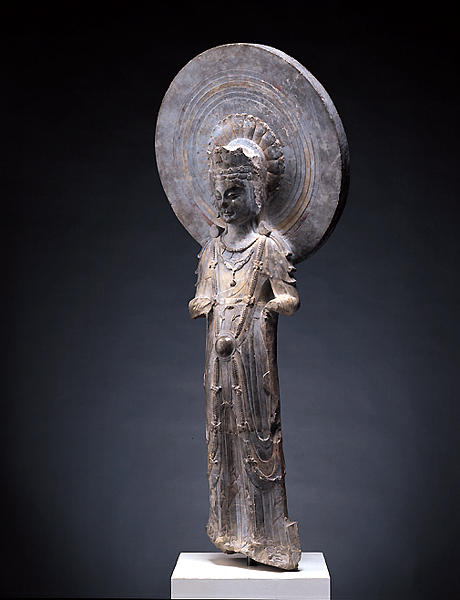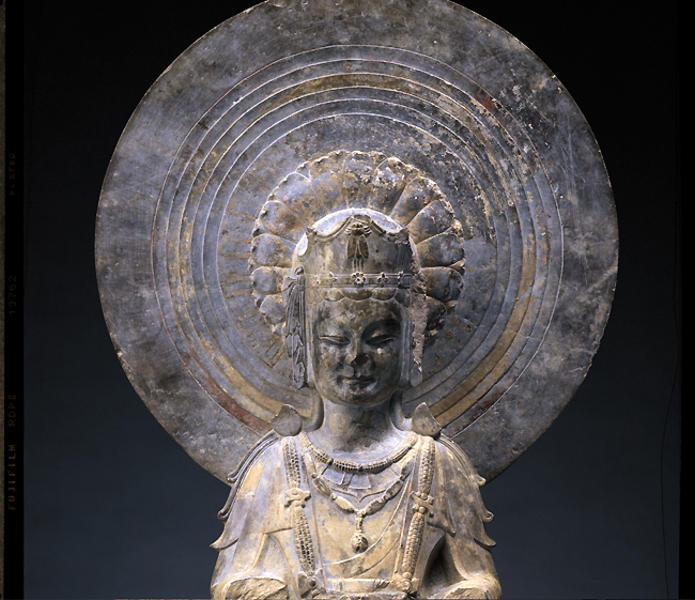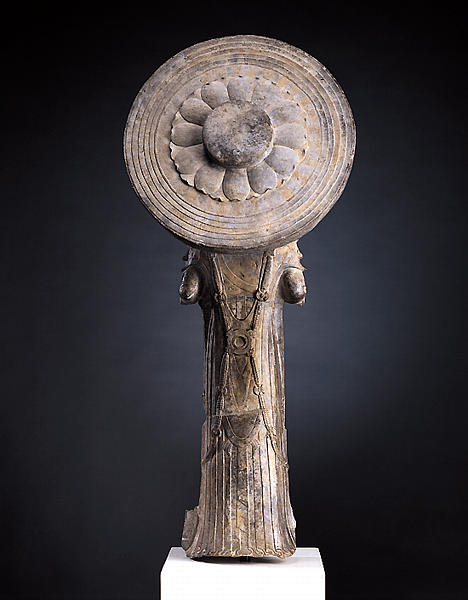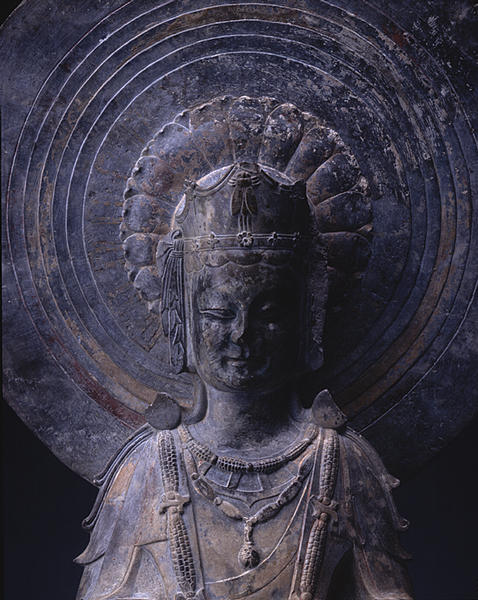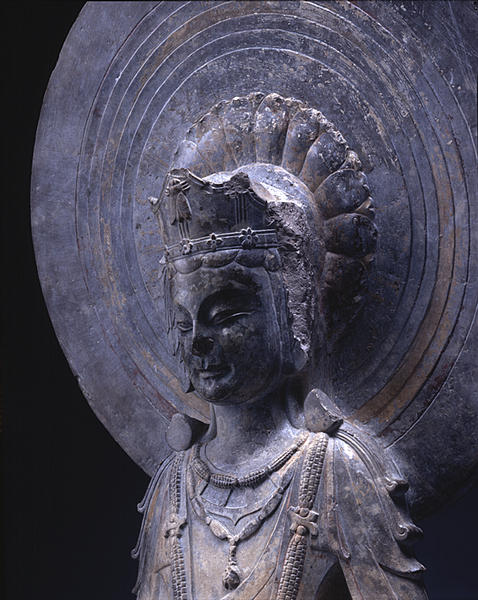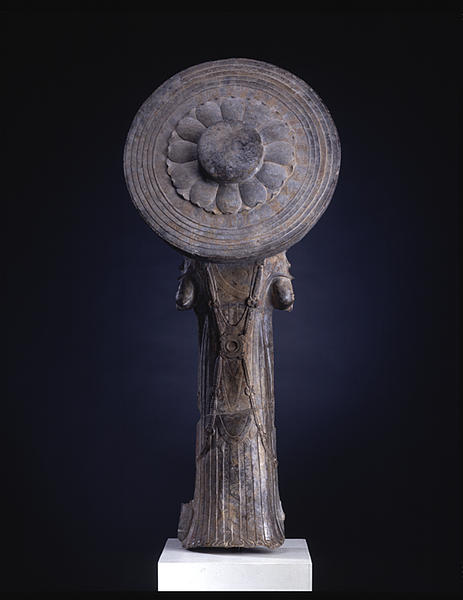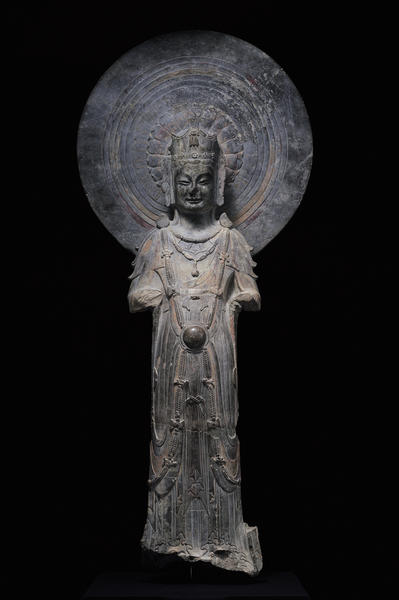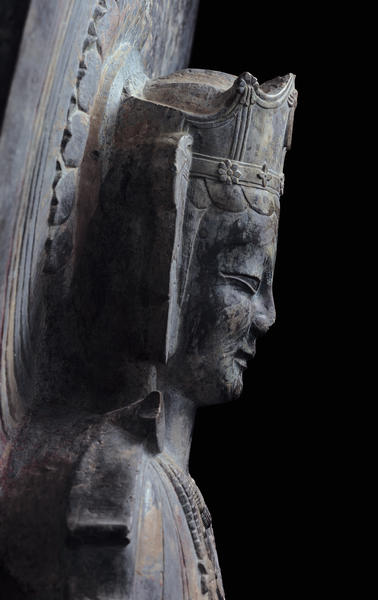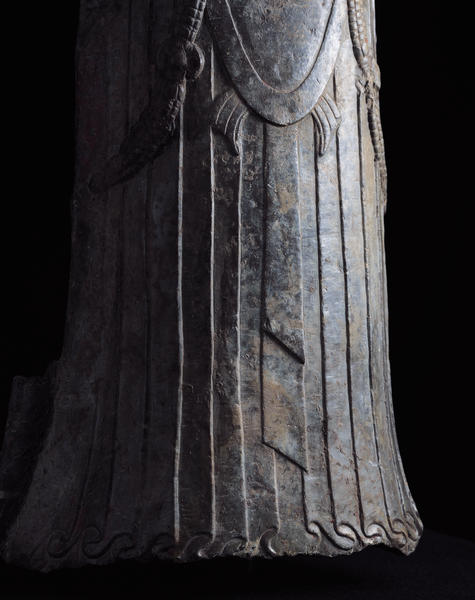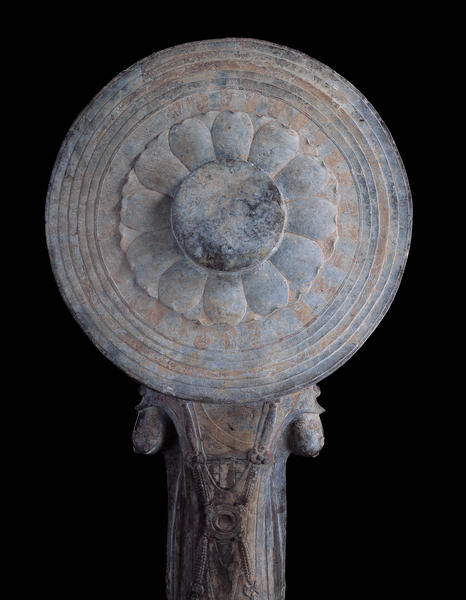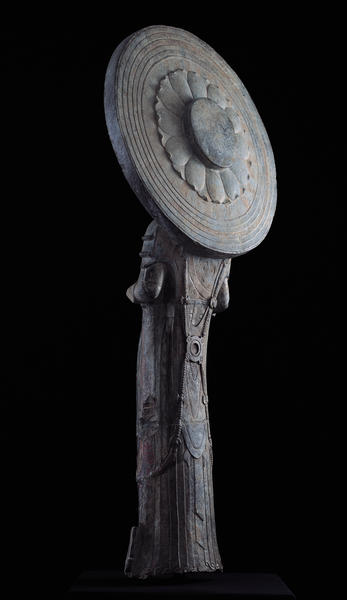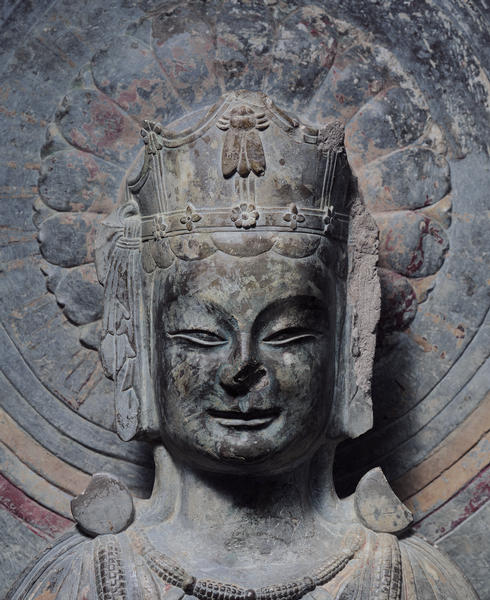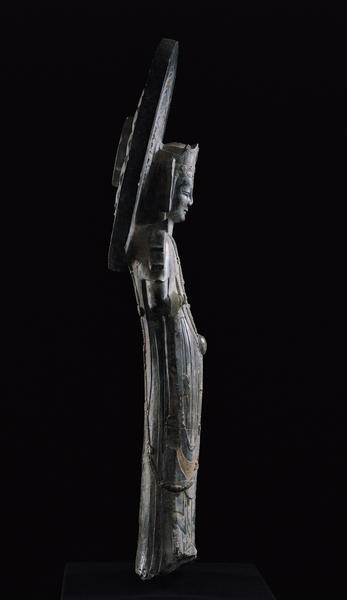菩薩立像
- 中国・山東省博興発見
- 中国・北魏時代末期-東魏時代
- 6世紀前期
- 石灰岩
- H-120.5
- 所蔵
- 中華人民共和国山東省所蔵
菩薩立像 1駆 120.3cm 石灰石製
北魏末から東魏時代(6世紀前半)
像は光背を含めて、頭体のすべて、おそらくは現在欠失している両手前膊部や天衣遊離部も含めて同じ石から刻出していたものと推定される。
この像は側面から見ると首と下腹をやや突き出す、いわゆる「久」字状に立っており、アルカイックスマイルをたたえる口元、下腹部でX字状に交わって膝辺りをめぐる天衣など、一見して北魏時代の龍門石窟で形成された様式を基調としていることが理解される。しかし、大きな円形の頭光、顔面部に見られる写実的な肉付けは、古陽洞や賓陽三洞の像には見られない要素であり、冠や肩飾りの簡素な成形も、肩にかかる二重に折り返した蕨手状の垂髪、中央部に玉状の垂れ飾りのある装飾性豊かな旨飾り、交差部に大きな半球状の飾りを伴う瓔珞、左右への広がりを弱め、左足側面に沿って垂下する天衣なども、ともにこの像がやや後の時代に造られたことを示している。一方、ややつり上がりぎみに上向きの弧を描く上まぶたと、一度下向きに膨らんでから目尻にむかって逆向きの弧を描きながらこれと合流する下まぶたの強い曲線で構成される目は、眉から鼻にかけての鎬立った稜線ともあいまって、たいへん厳しい印象をこの像に与えており、裳に刻まれた比較的幅の狭い平行線状の衣文には、やや崩れてはいるものの、中央から左右対称に品字形衣文が表され、背面ではやはり中央から左右対称に波形の襞が表されている。裳の表現からは下腹部の肉体の微妙な起伏や前面両足部の丸みが感じられる。しかし、これらの衣文表現は、決して立体的な襞の起伏としては表されず、すべて平面的に処理されている。像は左右対称を守る厳格な形式美の下にまとめあげられており、総体として大変荘重な趣を醸し出している。
本像の作風は立像ではないが麦積山石窟台142号窟の右壁交脚菩薩像などの北魏末期の像や、同台27号窟の正壁龕脇侍菩薩像など西魏大統年間(535ー551)の製作と推定されている像などに近い1。しかし、はるかに繊細な肉付けをもっており、浮彫と彩色を併用した大きな円形の光背は、もしも最外部の幅広帯に彩色で唐草の様なものを描いていたと想定し得るならば、山東省博物館所蔵の北魏正光6年(525)銘の石造三尊仏立像の中尊およびフリア美術館の北魏永煕三年(534)銘の釈迦三尊像、藤井有鄰館所蔵の東魏天平2年(535)銘石造三尊仏立像の中尊頭光等と形式が一致しており2、頭光の背面に刻まれた大きめの芯を持つ単弁式二重の見事な蓮華の表現は、中国・諸城県博物館所蔵の東魏武定3年(545)銘の石造三尊仏立像の中尊の頭光に見られる蓮華のそれに近い印象を持っている3。さらに作風的にもヒ゛クトリアアント゛アルハ゛ートミューシ゛アム 所蔵の東魏武定二年(544)銘の仏三尊像に近い4。しかし、松原三郎氏が東魏末から北斉初期の作と推定している諸城県博物館所蔵の金銅三尊菩薩像では、既に裳裾の衣文表現に本像よりも進んだ写実性を示しており、シンシナチィ・アート・ミューシ゛アム(米)所蔵の隋時代と推定される菩薩立像、および松原氏が6世紀の後半と推定しているロサンセ゛ルス・カウンティ・ミューシ゛アム所蔵の石造菩薩立像なども形式的には本像と通ずる点を持ちながら、はるかに自由で写実的な様式を備えている5。これらを勘案すれば、本像の作風は6世紀の前半、北魏末期から東魏時代の始め頃のそれに近いと考えられる。
また、本像の特筆すべき特徴に宝冠正面の蝉形冠飾りがある。このような表現は全く類例を知らない。しかし、中国においては戦国時代に趙の武霊王が胡族の風を取り入れてから、武官がこれを表す冠飾りを着用するようになり、以来皇帝の近臣や高級宦官が清廉、節倹の象徴として冠の前面に蝉の冠飾りを使用するようになったことが判明している6。さらに注目すべきは、北燕時代(409-436)の馮素弗の墓から問題の蝉形冠飾りとともに金製の山形冠飾りが出土しており、歩揺の付いたこの冠飾りの裏面に型押しで仏座像が表されていることである7。このことは本像が製作されたおよそ百年前に、冠飾りの裏に化仏を隠した崇仏の貴人が存在した事を示している。これによれば、化仏のかわりに蝉の冠飾りを付けたこのような菩薩像が、北朝伝統の皇帝即如来王侯即菩薩の思想に則り、崇仏の貴人になぞらえて製作された可能性を示していると考えられる。
さらにボストン美術館所蔵の閻立本筆「帝王図巻」によれば、冕服姿で描かれた帝王7人の内、冠の正面を確認することができる武皇帝劉秀、魏文帝曹丕、呉主孫権、蜀主劉備、晋武帝司馬炎、隋文帝陽堅の6人は、全員蝉の冠飾りを付けていることが確認される8。このことは蝉の冠飾りが帝王にも用いられたことをしめしている。一方「続高僧伝」卷十九の法蔵
南北朝
南北朝の美術
3世紀に漢が滅んだ後、4世紀には北方の遊牧民族が華北に侵攻し、漢族の王朝を華南の地へ追いやって華北に次々に国を建てました。これを五胡十六国時代とよんでいます。北魏はこのめまぐるしい王朝の交代劇を収め、華北を統一しますが、一方、南に追いやられた漢民族は東晋王朝を建て、ここに南北朝時代が成立します。
この時代の華北では、西方から交易を求めて人々がさかんに来朝し、西の文物が流入するとともに、雲岡石窟をはじめとする大石窟が西の彫刻様式を反映した仏像が石窟に刻まれました。
一方、江南では貴族をを中心として清談の風が高まり、漢民族の伝統的な文化を継承した洗練された芸術が生まれました。絵画の顧 之、書の王義之、詩の分野では陶淵明が活躍したのもこの時代です。しかし、江南の漢族王朝は政治的には脆弱で、以後、宋、斉、梁、陳という4つの王朝が次々と交代しました。
仏典の漢訳もすすんで、仏教の理解が飛躍的に深まるとともに、次第に中国人の感性に即した仏像様式が成立してゆきました。
この時代は後漢の滅亡後、華南に興亡した6王朝にちなんで、六朝時代とも呼ばれています。
Catalogue Entry
This magnificent bodhisattva's head, body, complete nimbus, floating scarves (known as ten-ne in Japanese), as well as the now-lost forearms, apparently were carved from one piece of limestone. The figure exudes dignity and a benign strength, and its strong, columnar form has been softened by the modeling of the drapery, the richness of the decorative elements, and a gentle S-shaped curve of the body―visible only from the side―produced by a forward thrusting of the neck and lower belly. The pleated drapery patterns on the lower garment (a high-waisted dhoti or mo) are depicted in narrow, parallel lines and very low planar relief, but they still define the slight protrusion of the lower belly and the roundness of both legs on the front of the image, the swell of which are further emphasized by the long thin scarves and thick strings of beads looping down from the shoulders to below the knees and crossing the stomach in an X, punc-tuated with a large hemispherical "jewel." On the back, there is a pattern of wave-form pleats falling symmetrically from the center; a bi-shaped disc marks the crossing of the scarves.
The large hemispherical jewel and two small discs, one on each shoulder, are connected by chains of beads and form a triangle that draws attention to the bodhisattva's extraordinary face and nimbus. The richness of the drapery patterns, the bead chains, and the necklaces create a striking contrast to the starkness of the nimbus, face, and crown. Stunningly austere, the nimbus has a wide undecorated band enclosing the edge, and concentric layered rings, culminating in a petaled lotus framing the crowned head. On the back of the nimbus, concentric layered rings decorate the outer edge and frame a petaled lotus with a plain disc at the center. The square head―which sits on a short columnar neck―has a face with rounded, almost fleshy cheeks; sharply defined, chiseled features; and an "archaic" smile; it supports a simple crown with a cicada-shaped decoration at the center.
At first glance, the sculptural treatment and decorative embellishments appear to have been based on the styles in the Longmen caves, Henan province, during the Northern Wei dynasty. The large circular nimbus and fleshiness of the face can be seen in the Guyang and Binyan caves at Longmen, which date from the end of the Northern Wei. At the same time, the stylistic features also reflect images dating from the end of the Northern Wei dynasty from the Maijishan cave temples in Gansu, whether the cross-legged bodhisattva images on the right wall of Cave 142 or the attendant bodhisattva in the niche on the main wall of Cave 27 that dates to the Western Wei dynasty (A.D. 535-551).*1 The Shumei figure's nimbus, in particular, parallels three Northern Wei images: the central image in a standing stone triad dated to A.D. 525 in the Fuji'I Yurinkan collection in Kyoto; the Shakyamuni triad dated to 534 in the Freer Gallery in Washington, D.C.; and the central image of a stone triad dated to 525 in the Shandong Provincial Museum in Jinan.*2 On the back of the nimbus, the depiction of the beautiful lotus flower with its double layer of single petals and large central pad recalls the lotus on the head nimbus of the central figure of the standing stone triad dated 545 (Eastern Wei dynasty) in the Zhu Cheng County Museum in central Shandong.*3 Furthermore, it is stylistically comparable to the Buddha triad dated to 544 in the Victoria and Albert Museum, London.*4
Another noteworthy characteristic of this superb sculpture is the cicada-shaped decoration on the front of the crown. To date, there are no other known Chinese Buddhist sculptural examples of this kind. However, cicada images can be found on gold mountain-shaped crown plaques that also are embellished with thin gold wire and granulation; these have been excavated from the tomb of Ping Sufu of the Northern Yan period (A.D. 409-436), and seated Buddha images were molded onto the back face of these crown ornaments.*5 These excavated materials would have been made some one hundred years before the present image and suggest that there were members of the aristocracy who revered Bud-dhism and hid Buddha images on the backs of their crowns. This suggests the possibility that the Shumei bodhisattva, with a cicada in place of a Buddha image, was created at the request of a member of the aristocracy who revered Bud-dhism and believed in the philosophy that the Emperor is the living Buddha, which may have dated back to the Northern court.*6
Finally, the stylistic characteristics of this extraordinary bodhisattva sculpture share certain elements with sculptures of the Asuka period (A.D. 538-645) in Japan, such as the Yumedono Kannon and the Kudara Kannon, both images of the Bodhisattva Avalokiteshvara, and the bronze Shitenno (four heavenly kings) images from Horyuji. Further research will be required to explore this relationship. HK
1 Art Institute of Maijishan 1987, pl. 110, p. 154.
2 Matsubara 1995, pls. 166b, 200, 232.
3 Ibid., pl. 286.
4 Kaigai ichin 1979, pl. 35.
5 Two examples of these gold plaques with cicada images have been excavated from tombs in northern nomadic states: one in an Earlier Chin grave at Dunhuang, Gansu province, which can be dated to A.D. 369 (see Kaogu 1974.3, pl. 7, no. 3), and two in an early fifth-century Northern Yan grave in Liaoning (see Wenwu 1973.3, p. 25, figs, 2, 3, 6). The beautiful example in the Minneapolis Institute of Art shows the cicada embellished with gold wire and granulation, but has no Buddha image on the back: see Juliano 1975, p. 32, no. 10.
6 It is important to note that of the thirteen emperors depicted in the famous Portraits of the Emperors scroll attributed to the Tang-period court artist Yan Liben (Museum of Fine Arts, Boston), six have crowns with cicada ornaments.
